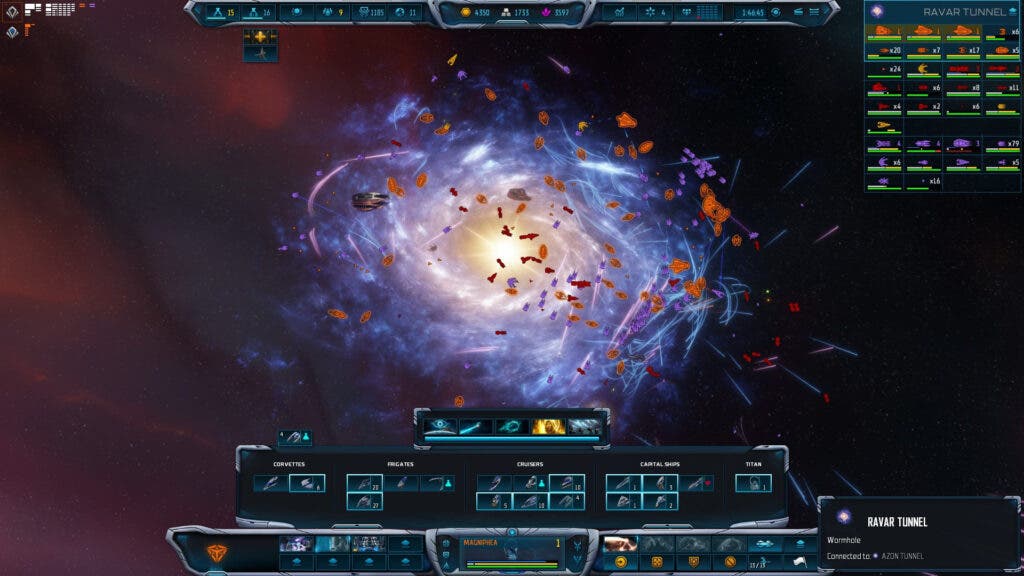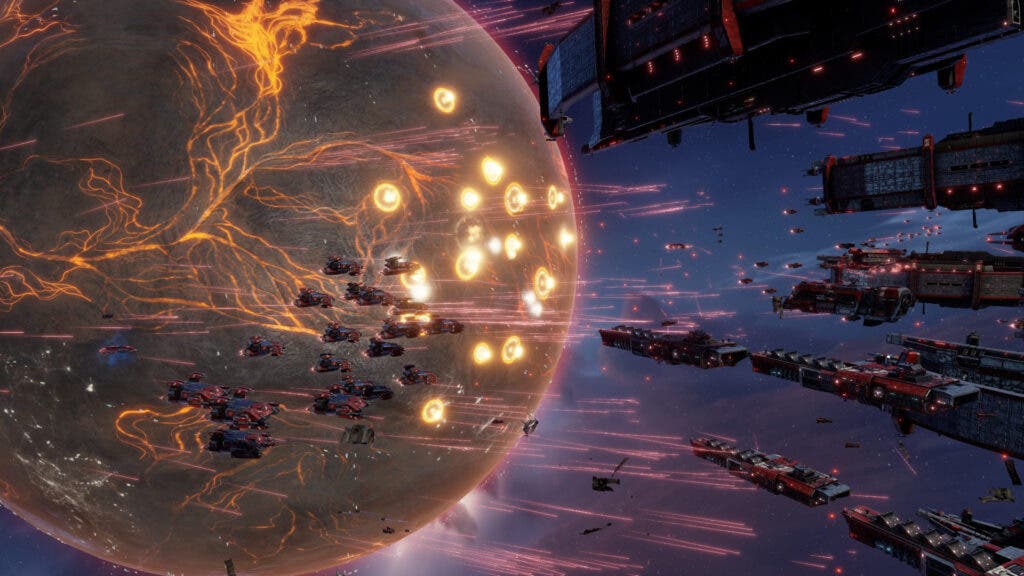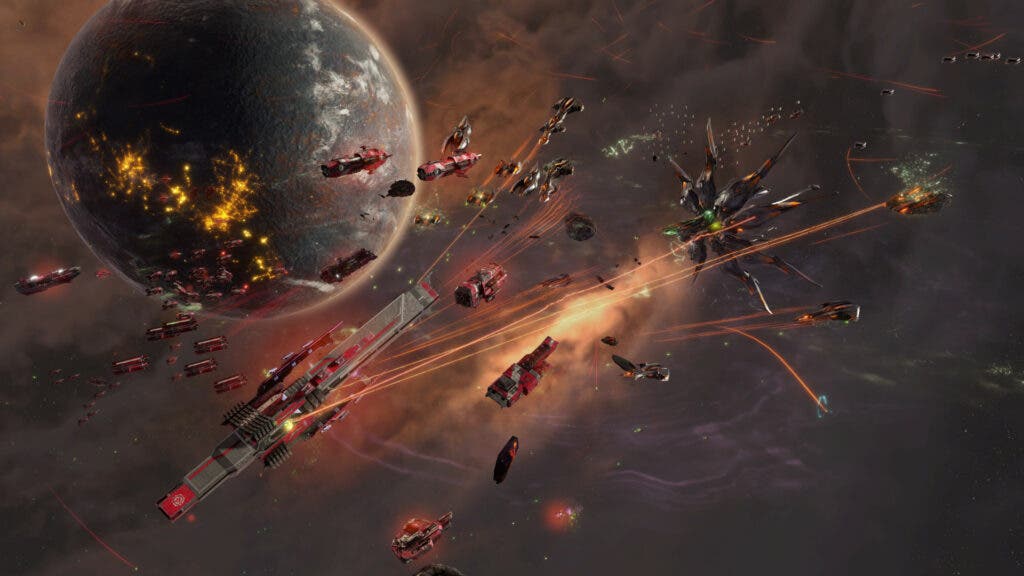How long has it been since a friend asked, “Which faction should I play as?” on our first game of Sins of a Solar Empire? 13 years? 14? My god, has it been that long? It feels odd to type that, especially after playing through another match of Sins of a Solar Empire II. In some ways, the sequel to the blend of 4X and Real Time Strategy almost feels like it barely changed, in others, it feels like a completely new game. If you, by any chance, read “4X and real time strategy” and thought about “Stellaris”, don’t. “Sins of a Solar Empire” not only predates Paradox blend of 4X and Grand Strategy, but it has much more emphasis on the “real time strategy” aspect. It is the almost perfect definition of “easy to pick up and learn, extremely hard to master”.

On a macro scale, “Sins of a Solar Empire II” almost plays itself. You set up scouts for reconnaissance, colonize planets, fight some neutral units from time to time and start establishing a foothold with structures like orbital stations for fighter production, missile defenses and whatnot. What the developer Ironclad Games doesn’t tell you is that you’re sitting on top of a pressure cooker ready to explode at any minute. And how you deal with that explosion is what sets each faction apart.
Instead of reinventing the wheel, Ironclad Games decided to keep it true to the previous game factions and with 3 major factions separated into two sides – one has a more defensive aspect and the other a more offensive one. For instance, if you start a game as the TEC Enclave, you can expect a strong focus on improving your economy either via trading, setting up defensive structures to your planets and slowly but surely building up your fleet.
On the other side of the coin there’s the TEC Primacy. While economy is a big part of its design, it is expected of you to build a military empire as fast as you can and colonize as many planets as possible. “Hit them strong and hard” as I like to call them.
The more you get into “Sins of a Solar Empire II”, the more advanced the factions become. Take the Vasari for example. Instead of having a “starter planet”, they enter the game with a capital ship and a possible colonizable planet. You can either choose to settle in it or do a risky maneuver of exploring for a more suitable planet. The Vasari can do that thanks to its reserve of exotic materials and its special ability of auto harvesting resources from ships debris from battles that happened either in their home planet or planets a jump away.
If your reply to the last sentence was “they can what”, welcome to “Sins of a Solar Empire II”.

On top of that there’s two types of research trees – one focused on civilian / economic and the other on defense / military – minor factions that you’ll have to deal with in due time and provide major bonuses if you can gain influence with them. And, of course, as I stated previously, exotic materials. They are key to building some of the biggest ships in the game and research the rarest technologies.
Okay, I know your head might be spinning at this point and you’re going “how the hell do I learn all this?”. Time, a lot of time. One match in Sins of a Solar Empire II can last up to 8 hours if you want it to. Heck, I saw tournaments back in Sins of a Solar Empire: Rebellion days where matches take up to 3 hours that was considered a “quick match”. So, no you don’t need, nor should, try everything in one go. You will lose a couple of matches until you get a good grip of every single mechanic. On the brightside, Ironclad Games did add a lot of Quality-Of-Life features that makes the learning curve less steep.
One I’m quite fond of is the new fleet customization system. While in previous games you had to properly understand the role of every ship to create a viable fleet, the game now nudges you to some recommended specs for ship tech and ship items – features available on bigger ships that can turn the tide of battle. It’s a great way to ensure that high level players can have a more “unique” fleet composition where newer players can quickly get an understanding that, if you have the resources, you can turn what appears to be a big battleship into a juggernaut of unstoppable force that casts a gravity well with nanobots that auto repair their hulls.
The notifications system also received a massive overhaul in terms of visuals and how it handles important messages. You will get a notification about a possible colonizable planet, once you hover the mouse on top of it will let you know if you have or not the requirements – to colonize it. If you don’t, you only have to click on it, and you’ll be taken to the research screen with the tech highlighted.

Even the fleet system, which was one of my main gripes with the previous entries, has been improved considerably. Did you just create a batch of new ships and want to add it to a current fleet? Right click on it and they not only will be assigned to it but also carry out the current orders that the fleet is assigned to. And, trust me, you’ll be doing a lot of that.
After all, as I stated in the first paragraph, “Sins of a Solar Empire II” does feel in some ways – especially for me who played a lot of “Sins of a Solar Empire: Rebellion” – the same game with a prettier coat of paint, better mechanics and a much more improved performance. It’s when the new features started coming into play that I went from “It’s great that’s not chugging on my system anymore” from “oh, that’s new… oh… I’m screwed”.
The feature that caused my reaction was the new “dynamic lanes” system. In short, the map spins around like a proper galaxy. This affects your planets, your orbital structures and to a lesser extent, your fleets. “Sins of a Solar Empire II” does have a feature that predicts where your planet will be in a couple of minutes, and you can automate so the game shits your orbital defenses to a new position. But my situation was a bit trickier.
Playing as the TEC Primacy, I was about to set course on a massive planetary invasion against the Vasari Exodus – a faction widely known for its defensive capabilities. I knew I would be going against massive defensive platforms, a couple of fleets and that I needed very strong and hard-hitting ships. Instead of going directly to the heart of its planets, I hesitated and waited until two researches were done – one would greatly increase my torpedoes damage and the other would improve my ships shields.
I hesitated, the planets shifted, my fleet was now stranded deep inside the map with nowhere to go but through two other factions – including my target – to reach a safe destination. I did manage to “sneak” through multiple defenses and arrive at a planet that, although wasn’t as developed as my bigger ones, it had enough turrets to fend off any pursuers. Dear readers, I was howling. This was one of the most amazing things I’ve witnessed in a game of “Sins of a Solar Empire” in a very, very long time. Such a simple mechanic that creates such amazing ramifications.

It doesn’t stop there, though. Ironclad Games finally added one of my most desired features: proper projectile simulation. That means that if you time it correctly, you can use ships as shields to protect some crucial infrastructure or even smaller ships such as frigates or scouts. As someone who played “Homeworld 3” and was deeply saddened by the lack of proper positional damage, moving a ship at the right time to see it block a massive assault on your capital in “Sins of a Solar Empire II” put a huge smile on my face.
And, while “Sins of a Solar Empire II” is great against AI, which is a rarity in a lot of strategy games, it gets even better against other players. Diplomacy is still rather barebones with mainly being used to trade resources or beg someone to stop harassing you in early game with a non-aggression pact. But the sequel reinforces diplomacy actions in a way that, if you break a pact or directly attack your opponent, you’ll get massive penalties on research time, mining output or commerce.
But once the gloves are off, it’s an all-out war, and it’s beautiful to watch ships going against each other. Planets exchanging hands, debris all over the place. Someone desperate that their fleet was completely destroyed and trying to gain favors with minor factions so they can act as a backup fleet while they try to rebuild their economy.
I won’t delve much into the micro side of things mainly because it’s a very advanced topic, and I want to save a bit of sanity for the rest of 2024. But I’ll say this: If you want to engage in micromanagement of your fleet, you can, and you’ll be able to outmaneuver your opponent in a multitude of ways. Every ship has a jump range, speed, hull and as stated above, can be fully customized. I can assure you that no two matches of “Sins of a Solar Empire II” will be the same.
I’m not the one to have a lot of hopes when it comes to future features in strategy games. 2024 taught me that I shouldn’t expect much more than the bare minimum from some developers. But “Sins of a Solar Empire II” is different. Ironclad Games have a clear idea of what they wanted to make and how to expand it. Have a solid foundation and every faction fleshed out, a good AI system, a good variety of maps — with or without procedural generation — proper mod support and work up from there.
As a “Sins of a Solar Empire: Rebellion” veteran, I do hope they add more interactions with minor factions – that as of right now is as much barebones as the diplomacy – more unique maps with special conditions, more victory options and, of course the main meal, its campaign. There isn’t exactly a date for any of those features yet, but they are coming down the pipe.
Taking into consideration how “Homeworld 3” campaign “Men of War II” campaigns panned out. Which is to say, I’d rather not have it at all than the current iteration, I’m more than glad to wait a couple of months, or even a year so that Ironclad Games take their time in refining what’s needed.

“Sins of a Solar Empire II” is more than capable of standing on its own even without a proper campaign. It already has great features, more depth than you can imagine and quality of life features that makes it very hard for me to get back to “Sins of a Solar Empire: Rebellion”. I know that I’ll jump back into the game, play more matches against the AI, check out mods and maps created by the community and perhaps annoy a couple of friends so we can set a match during a weekend. Will we be friends after 4 to 8 hours of multiple skirmishes? Only time will tell. 2024 has been one heck of a rollercoaster ride for strategy fans. Botched releases, broken promises and lackluster games. After playing “Sins of a Solar Empire II” I have only one thing to say: we are so back.
A Steam code was provided in advance by the publisher for review purposes
